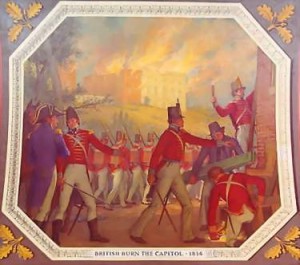So I have to admit that I am one of those statistics. I knew there was a War of 1812, but I actually had no idea what it was all about. I guess I thought it was against Mexico or the Indians.
Did you know that after the Revolutionary War and our Declaration of Independence, that the British Empire invaded again?
They sought to finally crush the uprising in the new territory of North America. They burned our capital in Washington, and sought to crush all resistance. Below is the text from Wikipedia

The War of 1812 was a war fought between the United States of America and the British Empire – particularly Great Britain and the provinces of British North America, the antecedent of Canada. Lasting from 1812 to 1815, it was fought chiefly on the Atlantic Ocean and on the land, coasts and waterways of North America.
The United States took the initiative in declaring war for multiple reasons. In 1807, Britain introduced a series of trade restrictions to impede on-going American trade with France, with which Britain was at war. The U.S. contested these restrictions as illegal under international law. Both the impressment of American citizens into the Royal Navy, and Britain’s military support of Native Americans who were attacking American settlers moving into the Northwest further aggravated tensions. Indian raids hindered the expansion of U.S. into potentially valuable farmlands in the Northwest Territory, comprising the modern states of Ohio, Indiana, Illinois, Michigan, and Wisconsin. Some British officials – and some dissident Americans – charged that the goal was to annex part of Canada, but they did not specify which part. The states nearest Canada strongly opposed the war.
Just as important, the United States sought to defend its national honour and sovereign rights against perceived British insults, such as the Chesapeake affair. Although the British made some concessions before the war on neutral trade, they insisted on the right to reclaim their deserting sailors. The American rallying cry of “free trade and sailors rights” reflected the dual economic and political aspects of the casus belli. The British also had the long-standing goal of creating a large “neutral” Indian state that would cover much of Ohio, Indiana and Michigan. They made the demand as late as the fall of 1814 at the peace conference, but lost control of western Ontario at key battles on Lake Erie, thus giving the Americans control of the proposed neutral zone.